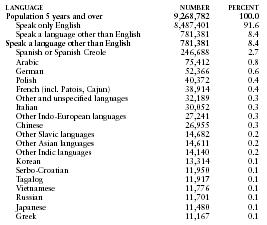Michigan
Languages
Before white settlement, Algonkian-language tribes occupied what is now Michigan, with the Menomini and Ojibwa in the upper peninsula and Ottawa on both sides of the Straits of Mackinac. Numerous place-names recall their presence: Michigan itself, Mackinaw City, Petoskey, Kalamazoo, Muskegon, Cheboygan, and Dowagiac.
Except for the huge industrial area in southeastern Michigan, English in the state is remarkably homogeneous in its retention of the major Northern dialect features of upper New York and western New England. Common are such Northern forms as pail, wishbone, darning needle (dragonfly), mouth organ (harmonica), sick to the stomach, quarter to four (3:45), and dove as past tense of dive . Common also are such pronunciations as the /ah/ vowel in fog, frog, and on; the /aw/ vowel in horrid, forest, and orange; creek as /krik/; root and roof with the vowel of put; and greasy with an /s/ sound. Swale (a marsh emptying into a stream) and clock shelf (mantel) are dying Northern words not carried west of Michigan. Pank (to pack down, as of snow) is confined to the upper peninsula, and pasty (meat-filled pastry) is borrowed from Cornish miners and heard in the upper peninsula and a few other areas. A minister is a dominie in the Dutch area around Holland and Zeeland.
Southern blacks have introduced into the southeastern automotive manufacturing areas a regional variety of English that, because it has class connotations in the North, has become a controversial educational concern. Three of its features are perhaps more widely accepted than others: the coalescence of /e/ and /i/ before a nasal consonant, so that pen and pin sound alike; the loss of /r/ after a vowel, so that cart and cot also sound alike; and the lengthening of the first part of the diphthong /ai/, so that time and Tom sound alike, as do ride and rod .
In 2000, 91.6% of the state's population five years old or older spoke only English at home, down from 93.4% in 1990.
The following table gives selected statistics from the 2000 census for language spoken at home by persons five years old and over. The category "Other Indo-European languages" includes Albanian, Gaelic, Lithuanian, and Rumanian. The category "Other Slavic languages" includes Czech, Slovak, and Ukrainian. The category "Other Asian languages" includes Dravidian languages, Malayalam, Telugu, Tamil, and Turkish. The category "Other Indic languages" includes Bengali, Marathi, Punjabi, and Romany.

| LANGUAGE | NUMBER | PERCENT |
| Population 5 years and over | 9,268,782 | 100.0 |
| Speak only English | 8,487,401 | 91.6 |
| Speak a language other than English | 781,381 | 8.4 |
| Speak a language other than English | 781,381 | 8.4 |
| Spanish or Spanish Creole | 246,688 | 2.7 |
| Arabic | 75,412 | 0.8 |
| German | 52,366 | 0.6 |
| Polish | 40,372 | 0.4 |
| French (incl. Patois, Cajun) | 38,914 | 0.4 |
| Other and unspecified languages | 32,189 | 0.3 |
| Italian | 30,052 | 0.3 |
| Other Indo-European languages | 27,241 | 0.3 |
| Chinese | 26,955 | 0.3 |
| Other Slavic languages | 14,682 | 0.2 |
| Other Asian languages | 14,611 | 0.2 |
| Other Indic languages | 14,140 | 0.2 |
| Korean | 13,314 | 0.1 |
| Serbo-Croatian | 11,950 | 0.1 |
| Tagalog | 11,917 | 0.1 |
| Vietnamese | 11,776 | 0.1 |
| Russian | 11,701 | 0.1 |
| Japanese | 11,480 | 0.1 |
| Greek | 11,167 | 0.1 |